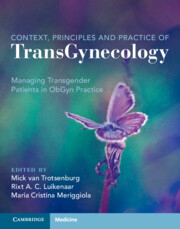Book contents
- Context, Principles, and Practice of Transgynecology
- Context, Principles, and Practice of Transgynecology
- Copyright page
- Dedication
- Contents
- Foreword
- Preface
- Contributors
- Abbreviations
- Section A Contextual Transgynecology
- Section B Practicing Transgynecology
- Chapter 9 Gynecological Office Medicine for Trans and Gender Diverse People
- Chapter 10 Features of Imaging in Transgender Persons
- Chapter 11 Benign Gynecological Conditions in Transgender and Gender Diverse People
- Chapter 12 Urogynecological Disorders
- Chapter 13 Painful and Frequent Micturition
- Chapter 14 Diagnostics and Treatment of Gynecological and Nongynecological Causes of Pelvic Pain
- Chapter 15 Gynecological Attention to the Prostate
- Chapter 16 Vaginal Dilators and Dilating after Vaginoplasty
- Chapter 17 Transenology
- Section C Gynecological Surgery for Transgender Males
- Section D Sexuality and Contraception
- Section E Fertility and Reproduction
- Section F Impact of Gender-affirming Hormonal Therapy on Genital Organs
- Section G Screening and Prophylaxis
- Transgynecology Index
- References
Chapter 13 - Painful and Frequent Micturition
from Section B - Practicing Transgynecology
Published online by Cambridge University Press: 22 December 2022
- Context, Principles, and Practice of Transgynecology
- Context, Principles, and Practice of Transgynecology
- Copyright page
- Dedication
- Contents
- Foreword
- Preface
- Contributors
- Abbreviations
- Section A Contextual Transgynecology
- Section B Practicing Transgynecology
- Chapter 9 Gynecological Office Medicine for Trans and Gender Diverse People
- Chapter 10 Features of Imaging in Transgender Persons
- Chapter 11 Benign Gynecological Conditions in Transgender and Gender Diverse People
- Chapter 12 Urogynecological Disorders
- Chapter 13 Painful and Frequent Micturition
- Chapter 14 Diagnostics and Treatment of Gynecological and Nongynecological Causes of Pelvic Pain
- Chapter 15 Gynecological Attention to the Prostate
- Chapter 16 Vaginal Dilators and Dilating after Vaginoplasty
- Chapter 17 Transenology
- Section C Gynecological Surgery for Transgender Males
- Section D Sexuality and Contraception
- Section E Fertility and Reproduction
- Section F Impact of Gender-affirming Hormonal Therapy on Genital Organs
- Section G Screening and Prophylaxis
- Transgynecology Index
- References
Summary
Painful and frequent micturition is a common cause of bothersome lower urinary tract symptoms (LUTS) in transgender populations, particularly in those undergoing gender-affirming surgery (GAS). Hormonal and surgical changes to the lower urinary tract may predispose patients to such symptoms. We discuss the prevalence, pathophysiology, and potential causes of painful and frequent micturition in transgender patients, including urethral stricture disease, urethral fistulae, urinary tract infection, dermatological disorders, primary bladder pathologies, and pelvic floor dysfunction.
- Type
- Chapter
- Information
- Context, Principles and Practice of TransGynecologyManaging Transgender Patients in ObGyn Practice, pp. 97 - 102Publisher: Cambridge University PressPrint publication year: 2022



